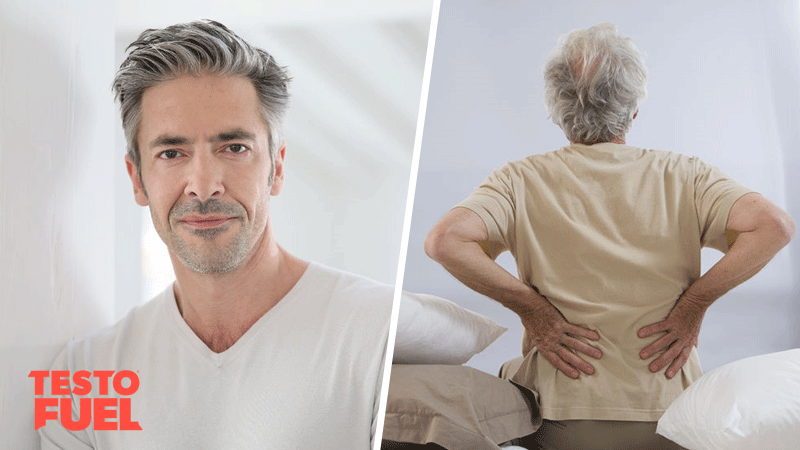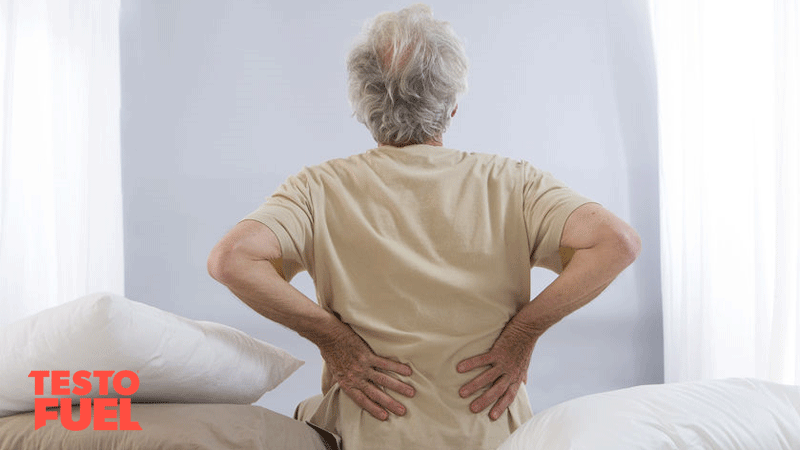TestoFuel Blog : Make Gains & Pack on the Muscle

It is a painful and debilitating illness that can leave you feeling frustrated and depressed.
Science is now showing that the hormone testosterone may play a bigger role than first thought, and with androgen receptors located in joint fluid, the relationship between the two seems a strong one.
If you want to know more about joint pain and low testosterone read on…
Testosterone is the primary male hormone responsible for promoting health, masculinity and athletic performance.
As a natural hormone, it is released from your testes as part of the hypothalamic-pituitary-gonodal axis. This means that in order for your testes to release the hormone, it has to receive stimulation from two glands in your brain – firstly the hypothalamus, and secondly the pituitary.
Testosterone is categorized as a steroid hormone under the family androgens. It regulates male characteristics such as:
From puberty onward, you experience a surge in testosterone production. It’s like your body finally found the ‘on-switch’ for the glands that trigger testicular release. You all of a sudden begin to grow facial hair, your shoulder get broader and you develop lean, muscular arms and chest.
You quickly become a man.
When your levels are optimized, testosterone is associated with good health, phenomenal stamina and strength. It affects your mood and temperament too – giving you an assertive yet powerful personality.
The problem is though that these benefits don’t last forever…
Although you enjoy the benefits of high testosterone during your late teens and twenties, circulating levels begin to decrease as you reach your forth decade of life.
With a steady decline of around 1-2% per year, both your assertive and confident personality and your muscular, lean physique begin to deteriorate.
Hypogonadism – the clinical name for low testosterone – comes with a number of unfortunate symptoms, ranging from metabolic and vascular, to cognitive and neurological.
When you think of low testosterone levels you might think low libido and sex drive.
But there’s much more to it than that.
Large scale research reviews suggest that hypogonadism is a reliable indicator of disease risk, and that maintaining a high testosterone level from age 30 onward is key to reducing long-term illness [1].
The main diseases associated with low T are:
Hypogonadism can affect your health so much that it even contributes to ‘all-cause mortality’ – early death.
A recent study in the Journal of Clinical Endocrinology and Metabolism [2] found that men who had hypogonadism (classified as a total testosterone levels of below 241 ng.dL) were as much as 40% more likely to die than those with higher hormone levels.
It’s that important to make sure your body runs as optimally as it can.
There are numerous potential causes of joint pain.
From playing a bit too much sport or hitting the gym with just a little too much enthusiasm, through to inflammatory, auto-immune disease such as rheumatoid arthritis. Swelling and pain in your joints can be both painful and debilitating.
And unless you’ve suffered from it you won’t understand just how bad it can be.
Redness, loss of function, loss of strength, swelling and searing pain are an inevitable part of the illness.
Although ageing can be a big risk factor for joint and back pain, there are also number of other contributing factors too. These include:

According to research, “there is evidence that androgens play a role in immune and inflammatory pathways” [3].
That’s more than likely because androgen receptors are present in synovial fluid – the small sack of lubricant that keeps your joints supple and unrestricted.
Recent research now shows that lower testosterone levels are a risk factor for joint pain from rheumatoid arthritis [4].
In the Annals of Rheumatic Diseases-published case control study, other factors such as age, gender, body weight and year of screening were taken into account. And even then, those with the lowest androgen levels were much more likely to develop joint pain.
Those with lowest testosterone levels also showed a sharp increase in follicle stimulating hormone right before the onset of rheumatoid arthritis too. As a hormone that is indicative of a poorly functioning reproductive system and hormone production, FSH is a good indicator of hormonal health.
The authors of the study concluded by saying that not only does low testosterone create a risk factor for joint pain, it can also make symptoms worse.
Another study found that there was a clear link between low serum testosterone levels and a type of gene called HLA [5].
As a type of antigen, HLA genes are important regulators of joint health and when levels are not functioning, risk of joint diseases increases (arthritis, Reiter’s disease and ankylosing spondylitis).
Lastly, a study published in the aptly titled journal Rheumatology [6] suggests that there are a significant number of men with rheumatoid arthritis that have low androgen levels. The study went on to suggest that low testosterone may have a ‘pathogenic role’ in joint, bone and back conditions.
From 104 men with joint pain, 33 were found to be hypogonadic. Although that might sound like a huge number, compared to the 7 that didn’t have low T makes it a more than significant amount.
The men were found to have low testosterone as well as other regulators of healthy androgens too.